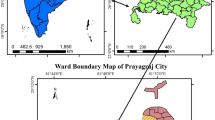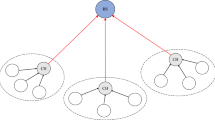Abstract
This paper proposes an access network selection algorithm based on a cooperative strategy with Chi square distance, subjective weights for traffic classes and objective attributes of network. The algorithm gets the subjective weights of attribute in four traffic classes using AHP at first, then calculates objective weights using a cooperative method of entropy weight and criteria importance though intercriteria correlation. The final weights are obtained by a comprehensive weighting method based on minimizing the deviation between weights. Finally we measure the Chi square distance between every candidate network and the ideal network and choose the one which has the minimum Chi square distance to the idea network as the best access network. Simulation results show that the proposed algorithm can select the most suitable access network to meet the requirements of current traffic and observably extend the discernibility between candidate networks. The ratio between the best and the second-best network in this algorithm is 8 or 9 times bigger than that in technique for order preference by similarity to ideal solutions, simple additive weighting and grey relational analysis. Furthermore, it can avoid falling into local optimal situation, choose the correct optimal access network when some network attributes appear extreme data, and has good algorithm robustness.




Similar content being viewed by others
References
Anahita, M., & Francesco, B. (2012). Opinion dynamics in heterogeneous networks: Convergence conjectures and theorems. Journal on Control and Optimization,50(5), 2763–2785.
Mohamed, L., Leghris, C., & Abdellah, A. (2012). An intelligent network selection strategy based on MADM methods in heterogeneous networks. International Journal of Wireless & Mobile Networks,4(1), 83–96.
Erchin, S., Jang-Sub, K., Dong-Ryeol, S., & Khalid, Q. (2008). Handoff triggering and network selection algorithms for load-balancing handoff in CDMA-WLAN integrated networks. EURASIP Journal on Wireless Communications and Networking,1, 136939.
Yan, X., Mani, N., & Sekercioglu, Y. A. (2008). A traveling distance prediction based method to minimize unnecessary handovers from cellular networks to WLANs. IEEE Communications Letters,12(1), 14–16.
Huang, C. Y., Juan, H. H., Lin, M. S., et al. (2007). Radio resource management of heterogeneous services in mobile WiMAX systems [Radio Resource Management and Protocol Engineering for IEEE 802.16]. IEEE Wireless Communications,14(1), 20–26.
Sheng-Mei, L., Su, P., Zheng-Kun, M., Qing-Min, M., Ming-Hai, X. (2010). A simple additive weighting vertical handoff algorithm based on SINR and AHP for heterogeneous wireless networks. In 2010 International conference on intelligent computation technology and automation, ICICTA 2010, vol. 1, pp. 347–350.
Nguyen-Vuong, Q. T., Ghamri-Doudane, Y., Agoulmine, N. (2008). On utility models for access network selection in wireless heterogeneous networks. In NOMS 2008—IEEE/IFIP network operations and management symposium: Pervasive management for ubiquitous networks and services, 2008, pp. 144–151.
Bari, F., & Leung, V. (2007). Multi-attribute network selection by iterative TOPSIS for heterogeneous wireless access. In 2007 4th annual IEEE consumer communications and networking conference, CCNC 2007, pp. 808–812.
Kuo, Y., Yang, T., & Huang, G. W. (2008). The use of grey relational analysis in solving multiple attribute decision-making problems. Computers & Industrial Engineering,55(1), 80–93.
Wang, K., Zheng, Z. M., Feng, C. Y., et al. (2009). A heterogeneous network selection algorithm based on multi-attribute decision making method. Radio Engineering of China,39(1), 1–3.
Kong, L. J. (2011). Simulation research on network selection algorithm of heterogeneous wireless network. Computer Simulation,28(8), 107–111.
Lahby, M., Cherkaoui, L., Adib, A. (2012). Network selection algorithm based on Diff-AHP and TOPSIS in heterogeneous wireless networks. In Proceedings of 2012 international conference on multimedia computing and systems, ICMCS 2012, pp. 485–490.
Sheng, J. (2013). Access selection algorithm for heterogeneous wireless networks based on rough set and analytic hierarchy process. Computer Applications & Software,30(2), 133–136.
Saaty, T. L. (2010). Decision making for leaders: The analytic hierarchy process for decisions in a complex world. RWS Publication.
Sheng, J., Qi, B., Dong, X. J., et al. (2012). Entropy weight and grey relation analysis based load balancing algorithm in heterogeneous wireless networks. In 2012 International conference on wireless communications, networking and mobile computing, WiCOM 2012.
Diakoulaki, D., Mavrotas, G., & Papayannakis, L. (1995). Determining objective weights in multiple criteria problems: The critic method. Computers & Operations Research,22(7), 763–770.
Wang, J., Wang, L. (2014). Heterogeneous network selection algorithm based on the subjective and objective weights. Electronic Science & Technology, 2014(3), 5–10.
Lu, Z., Zheng, Q., Yang, W., et al. (2012). Adaptive image segmentation based on local neighborhood information and Gaussian weighted chi square distance. In Proceedings—international symposium on biomedical imaging, pp. 1240–1243.
Acknowledgements
This study is supported by Natural Science Foundation of Guangdong Province (2017A030307035), Innovative Research Project of the Education Department of Guangdong Province (2017KTSCX127), Key Collaborative Innovation Project among Industry, University and Institute of Guangzhou (201604010001).
Author information
Authors and Affiliations
Corresponding author
Additional information
Publisher's Note
Springer Nature remains neutral with regard to jurisdictional claims in published maps and institutional affiliations.
Rights and permissions
About this article
Cite this article
Yu, H., Chen, L. & Yu, J. Network Selection Algorithm Based on Chi-Square Distance in Heterogeneous Wireless Networks. Wireless Pers Commun 111, 1625–1643 (2020). https://doi.org/10.1007/s11277-019-06946-2
Published:
Issue Date:
DOI: https://doi.org/10.1007/s11277-019-06946-2




